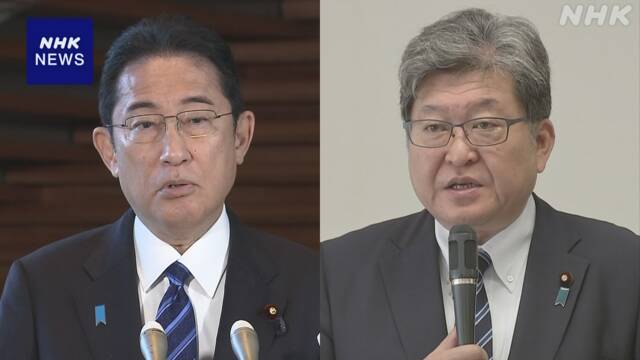With regard to the new economic measures, Prime Minister Kishida met with LDP Political Research Chairman Hagiuda on the evening of March 20 and instructed the party to specifically consider reducing income tax in order to return a part of the increase in tax revenue to the public.
With regard to the new economic measures to be finalized by the government in the near future, Prime Minister Kishida has stated that he will take all possible measures to appropriately return a portion of the increase in tax revenues to the people facing soaring prices.
Against this backdrop, Prime Minister Kishida held a meeting with LDP Political Research Chairman Hagiuda at the Prime Minister's Office for approximately 20 minutes on the evening of November 15.
He instructed Mr. Hagiuda to consider specific income tax cuts within the party.
After the meeting, Mr. Hagiuda told reporters that the specific method of tax reduction was "certainly not a permanent tax cut, and I would like to start considering how to ensure that the economic measures, including the schedule and volume, are firmly in line with the economic measures."
In addition, he indicated that a reduction in income tax would not reduce the burden on tax-exempt households, and that he would consider taking benefit measures at the same time.
On the other hand, regarding consistency with the tax hike to finance the increase in defense spending, he said, "It is difficult to understand why we will also raise the defense tax from next year when considering tax reduction measures from now on, and we would like to design a system that will not raise taxes next year."
Prime Minister Kishida is also expected to meet with Komeito Political Research Chairman Takagi and others to ask them to consider reducing the income tax.
Income tax reduction implemented as an economic measure in the past
In the past, income tax reductions that were implemented as economic measures include ▽ "flat-rate tax reduction" that uniformly deducts a certain amount from the
tax payment amount = deduction and ▽
"flat-rate tax reduction" that deducts a certain percentage uniformly.
The Hashimoto Cabinet implemented a flat-rate tax cut in 1998.
In December of the previous year, the Diet passed a related law in January, and the tax was reduced from the withholding tax in February.
In addition, additional tax cuts were made in the middle of the year.
As a result, 12,1 yen was deducted uniformly from the annual tax payment, and 2,3 yen per person was deducted if they were dependent on a spouse or children.
The amount of income tax reduction was on the scale of 8000.1 trillion yen.
On the other hand, in 1, the Obuchi Cabinet implemented a flat-rate tax cut.
Positioned as a "permanent tax reduction," 9000% of the tax amount was deducted up to 2,8000 yen.
Until the tax reduction amount reaches the upper limit, the higher the income, the higher the tax reduction.
The amount of income tax reduction that year was on the scale of 1999.25 trillion yen.
This flat-rate tax reduction was halved to 20% in 2 and abolished the following year, in 6000.
In both cases, the inhabitant tax was also reduced.
Income tax reduction going forward
Consideration of tax cuts will begin in earnest in the future, but it is expected that opinions will also be exchanged on how to deal with low-income earners, arguing that income tax cuts will not sufficiently benefit households with low or tax-exempt taxes.
In addition, tax revenues from the general account for the last fiscal year increased by more than 4 trillion yen from the previous fiscal year to a record high of more than 71 trillion yen in line with the economic recovery, and income tax increased by more than 1 trillion yen to more than 22 trillion yen.
However, the government's fiscal situation continues to be severe in which more than 3% of revenues are dependent on the issuance of new government bonds in this fiscal year's budget, and expenditures are expected to increase in the future due to the strengthening of defense capabilities and measures to address the declining birthrate.
Therefore, it is expected that discussions will be held on the scale and duration of the tax cuts, as well as their effectiveness as measures against rising prices and the balance with fiscal discipline.

